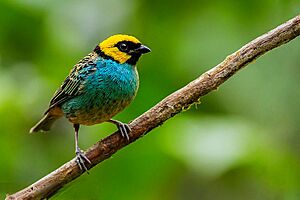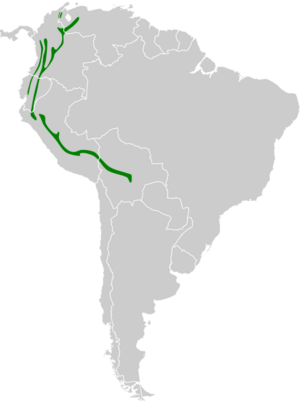Saffron-crowned tanager facts for kids
Quick facts for kids Saffron-crowned tanager |
|
|---|---|
 |
|
| Conservation status | |
| Scientific classification | |
 |
|
| Distribution of the saffron-crowned tanager | |
| Synonyms | |
The saffron-crowned tanager (Tangara xanthocephala) is a beautiful bird found in the northern Andes mountains. These birds live in countries like Bolivia, Colombia, Ecuador, Peru, and Venezuela. They love to hang out in cloud forests, along the edges of forests, and in younger secondary forests. You can often find them where there are lots of mossy trees.
This tanager is a medium-sized bird. It has a blue-green body and a bright yellow head. Some parts of its head, like the front of its crown, around its eyes, and its chin, are black. Saffron-crowned tanagers usually look for food in pairs or small groups. They often join bigger groups of different bird species. They mostly eat fruits, but they also enjoy insects. These birds are thought to stay with one partner for breeding. The only known nest had two eggs. The International Union for Conservation of Nature (IUCN) says this bird is of "least concern," meaning it's not in immediate danger. However, losing their habitat (where they live) could become a problem for them.
Contents
About the Saffron-crowned Tanager
The saffron-crowned tanager was first described in 1844 by a person named Johann Jakob von Tschudi. He called it Callospiza xanthocephala back then. The name Tangara comes from a word in the Tupi language that means "dancer." The second part of its scientific name, xanthocephala, comes from Ancient Greek words. Xanthos means yellow, and kephalos means -headed. So, its name literally means "yellow-headed dancer"!
This bird is one of 27 different species in the Tangara group. Scientists have studied their DNA to understand how they are related to other tanagers. The saffron-crowned tanager is closely related to birds like the blue-whiskered tanager and the golden tanager.
Types of Saffron-crowned Tanagers
There are three recognized types, or subspecies, of the saffron-crowned tanager. They mostly look alike, but their yellow crowns can be slightly different colors.
- T. x. venusta: This type lives from southern Venezuela down to central Peru. Its crown is a pure yellow color.
- T. x. xanthocephala: This is the original type, found in central Peru.
- T. x. lamprotis: This type lives from southeastern Peru to Bolivia. Its crown has a bit more orange in its yellow color.
What the Saffron-crowned Tanager Looks Like
The saffron-crowned tanager is a medium-sized bird. It is about 12.5 to 13.5 centimeters (5 inches) long. It weighs between 15 and 23.6 grams (about half an ounce). Both male and female birds look very similar.
Adult birds have a pretty blue-green body. They have some black streaks on their back. The front part of their head, around their eyes, and their chin are black. The rest of their head is bright yellow, and the very top of their head (the crown) might have an orange tint. Their wings and tail feathers are black with blue-green edges. The middle of their belly and the feathers under their tail are a light brown color. They have dark brown eyes, a black beak, and gray feet.
Young saffron-crowned tanagers look a lot like the adults, but their colors are not as bright. Their heads are more yellowish-green instead of bright yellow.
You might confuse this bird with the golden-eared or flame-faced tanagers. But you can tell the saffron-crowned tanager apart because the golden-eared tanager has a black middle crown, and the flame-faced tanager has a solid black back.
Bird Calls and Songs
The saffron-crowned tanager makes a thin, high-pitched "tsit" sound. It also has a high-pitched "tsew" call that goes down in tone. Their songs are often a series of squeaky, high-pitched notes.
Where They Live and Their Home
You can find the saffron-crowned tanager in the Andes mountains. They live in Bolivia, Colombia, Ecuador, Peru, and Venezuela. They prefer cloud forests, the edges of forests, and younger forests that are growing back. They also like shaded areas with large trees near open fields. These birds especially love places with lots of mossy trees. They usually live at heights between 1,000 and 2,700 meters (about 3,300 to 8,900 feet) above sea level.
How They Behave
Saffron-crowned tanagers are usually seen in pairs or small groups of 3 to 10 birds. They often join larger groups of different bird species, especially other tanagers and birds that live in the treetops. In Venezuela, they are often seen with the beryl-spangled tanager, golden tanager, and black-capped tanager.
What They Eat
This tanager eats more fruit than any other bird in its group. They enjoy fruits from plants like Cecropia, Morus, and Miconia. Besides fruit, they also eat insects.
These birds are very active when they are looking for food. They are always moving around or hopping from branch to branch. They mostly find fruit in the top parts of the trees. When they eat fruit, they usually stay upright. But when they hunt for insects, they often search on mossy branches. They look on both sides of the branch, reach into clumps of moss, or even stick their whole head into the moss to find bugs!
Reproduction and Life Cycle
Saffron-crowned tanagers form pairs for breeding. Scientists believe they are socially monogamous, meaning they stay with one partner. Birds ready to breed have been seen from March to July. Young birds have been spotted in different months depending on the country, like April in Venezuela or February in Peru.
Only one nest has ever been found. It was discovered in November, about 12 meters (39 feet) high in a tree. The nest was built in moss on the underside of a low branch. It contained two eggs.
Conservation Status
The saffron-crowned tanager is listed as a species of "least concern" by the International Union for Conservation of Nature (IUCN). This is good news because it means the bird has a wide range and its population is not dropping quickly. However, like many other animals, the saffron-crowned tanager could be threatened by habitat destruction. This happens when the forests where they live are cut down or changed by humans. Protecting their forest homes is important for their future.


